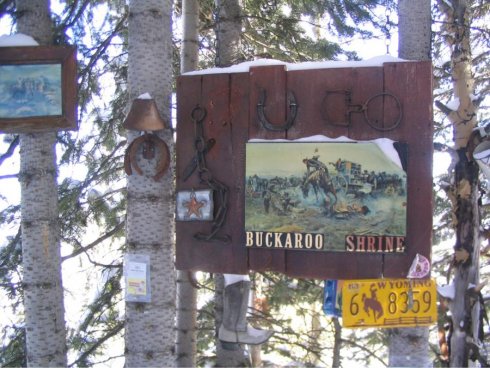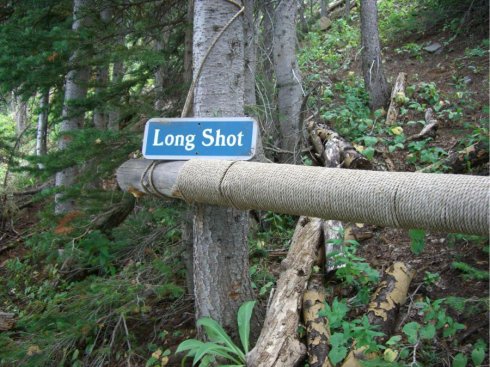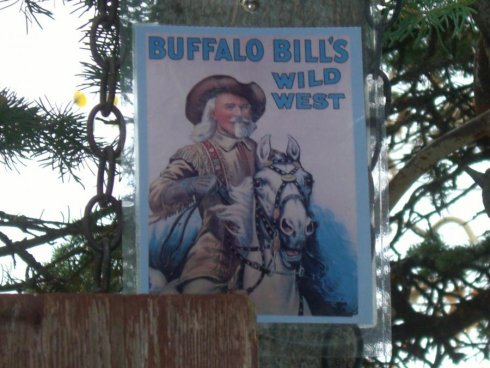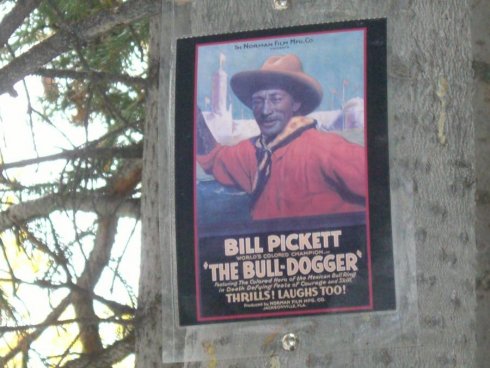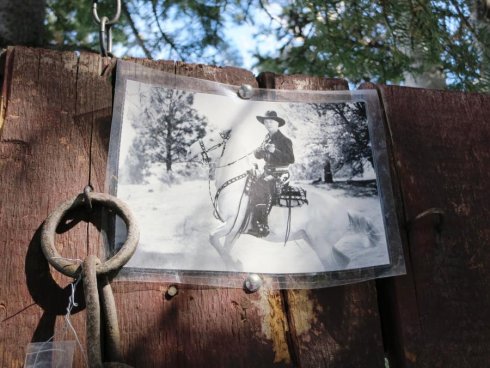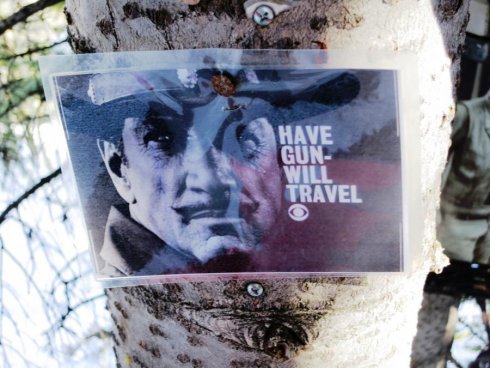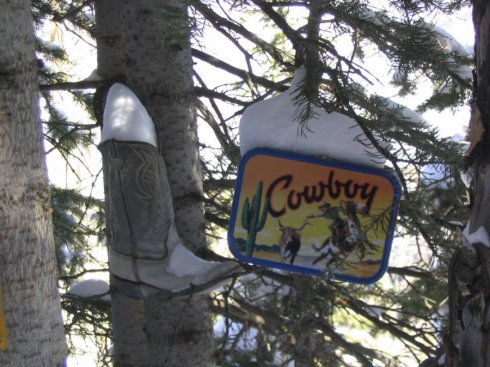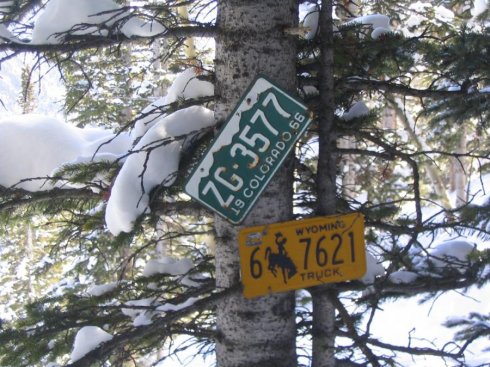The Buckaroo Shrine is maintained by the infamous ski gang, The Bell Mountain Buckaroos. Many of the members of this group are ski patrollers, ski school instructors, or others employed by the Aspen Skiing Company, and many of them or their families are ranchers in the Roaring Fork Valley. The group started in 1971 with eight people and every year since then they have participated in the "Rumble on the Ridge" (called the "Buck Off" by the Buckaroos) which has become a rite of spring on Aspen Mountain. It is basically an on-mountain free-for-all that takes place on the Ridge of Bell at 1:00 pm on the last day of the ski season. Usually several hundred people show up for it. Watching that many people trying to ski or ride down the Ridge of Bell all at once is quite a site! Sid Erickson won the first Rumble on the Ridge, which was held on March 10, 1971. In addition to the Buckaroos, Acme Racing and the Flynn Flyers also participated in the first Rumble. Also, see this article at AspenSpin.com: http://aspenspin.squarespace.com/the-partys-over/single-gallery/1138017 See this video; click the link and advance to the 0:48 mark: https://www.youtube.com/watch?v=MGhCVifDPws "This film segment is from Dick Barrymore's 'The Golden Years of Ski Films.' It highlights the origins of skiing and of Hot Dog Skiing. The World's first Hot Dog contest was on March 10, 1971 at Aspen Colorado. Some skiers featured are Dave Wheeler, Squirrel O'Callahan, Scott Brooksbank, Airborne Eddie Ferguson, and Greg Athens."
According to a March 11, 2014 article "Ski Gangs of Aspen" by Greg Fitzsimmons (set out in full below) Mark Hesselschwerdt was one of the founding members of the Bell Mountain Buckaroos Gang.
The shrine has a bench to sit on (a log with rope wrapped around it) and many interesting things to look at, including a sign that says “Cowboy Parking Only—All others will be whupped,” a coffee pot, a sign that says “Buckaroo Shrine,” a cowboy lunch box, an old cowboy boot, a coil of barbed wire, a Wyoming license plate, a Colorado “ZG” plate, signs that say “Rodeo Drive,” “Long Shot,” and “Shrine Line,” a sign that says “Real cowboys never line dance, a buckaroo won’t even watch!” and various other items and pictures.
See the article in the Snowmass Sun newspaper of April 11, 2012, "The Shrine Line on Aspen Mountain" by David Wood, which is set out in full below at the bottom of this page.
See this March 7, 2018 Aspen Sojourner article by Brooks Sutton, "Spring Parties That Are Fueled by Locals" published in the Midwinter 2018 issue of Aspen Sojourner. Here is a quote from this article: "On April 15 one of Aspen’s longest-standing spring traditions, the Bell Mountain Buck-Off, hits its 47th year. Established in 1971 (one year it got rained out) by local ski gang the Buckaroos of Bell Mountain, this throwback to freestyle’s 1970s heyday is an all-out, costumed ski en masse down the moguls on Aspen Mountain’s Ridge of Bell. Always held at 1 p.m., the bump bash has become the unofficial swan song for the ski area’s closing day. Up to 300 skiers, including some rival ski gangs, show their stuff. But the only things rough and tumble about the event are the size of the bumps and the trash talk." https://www.aspensojo.com/articles/2018/3/7/locals-springs-parties
The Buckaroo Shrine is located on Aspen Mountain. Photos of it are below.
If you have any information about this item that you would like to share for use on this page, please send to the author at [email protected].
********************************************************
SKI GANGS OF ASPEN
Mar 11, 2014 By: Greg Fitzsimmons
https://www.tetongravity.com/story/ski/Ski-Gangs-Of-Aspen-5981227
Editor's Note: Through the years, we often return to this story by Greg Fitzsimmons, rereading it with the same excitement we had when we first encountered it. The story serves as a chronicle of a key era in skiing's history, as well as a reminder of its timeless ability to elicit good times.
Drugs ran rampant and territorial rumbles were commonplace — Aspen in the 1970s was a gangland. It was a tableau of the Wild West where an eight ball of cocaine could be bought from your server at a handful of popular restaurants and a few local crews were in charge.
Just like today, there were two sides to the atmosphere in Aspen. Shrouded in opulence, the wealthy sipped wine in penthouse apartments and lived lavishly in their ski-in, ski-out condominiums. Meanwhile, at the ground floor (and even in underground locales), the original ski bum generation was migrating to Aspen in droves. In search of parties and powder, kindred spirits quickly started grouping together. They’d look for untouched lines in the spruce groves on Ajax in the morning and rage in the subterranean bars late at night.
Brought together by an affinity for powder, a desire to ski with the best in town, and never-ending nights of debauchery, ski gangs formed in Aspen during the 1970s.
THE PREDECESSORS
Two different cliques paved the way for the post-war, post-college (or flunked out) ski bums. It all started with a duo of brothers from Southern California and a lone guy from Colorado’s front range. Jack and Don Crawford and Gene Reardon were at the epicenter of Aspen’s skiing and partying scenes in the late 1960s. In direct contrast to the ski bums that would soon follow these three guys up into the Rockies, the Crawfords and Reardon had endless bankrolls and they generously used their wealth to throw some of the best parties Aspen has ever seen.
The Crawfords quite literally struck it rich in the ’60s, finding oil along the coast of Huntington Beach and parlaying the crude into a multi-million dollar business. At the same time, Gene Reardon (known as “Chief” because of the long headdress he would sport late at night) was a Denver-based attorney. The “Chief” amassed a fortune as a trial attorney while garnering an appreciation for life’s finer things: powder days, long nights, Danish supermodels, and vintage wines.
Long before rocking a “one-z” on the mountain was cool or the closing party at Aspen Highlands was canonized as one of the biggest on-snow shindigs in Colorado, the Crawfords and “Chief” Reardon were throwing raucous parties where people would dress up or dress down (clothing was optional), and get after “it.”
With deep pockets and a penchant for partying, Jack Crawford and Gene Reardon were the original godfathers of Aspen’s ski gangs. Groups of hangers-on and friends rode their coattails, and their entourages became the first ski gangs in Aspen.
THE RISE OF THE SKI BUM
An article in the January 1963 issue of Time magazine said, “For boys, Aspen has some reputation as the place where the girls are. ‘The basic thing here is the lack of supervision,’ says Student Steve Barinka of San Diego Junior College.’” A good ratio of girls to guys in a mountain town — which is still an enigma — combined with the epic nightlife made infamous by the likes of the brothers Crawford and “Chief” Reardon, plus the end to the Vietnam War and world-class skiing, brought about the influx of ski bums in the late ’60s and early ’70s to Aspen.
Mark Hesselschwerdt, a founder of The Bell Mountain Buckaroos gang, fit the mold. Recently flunked out of college, Hesselschwerdt and his brother were en route to Aspen from Bozeman, Montana, in the fall of 1971. “We stopped at the Rossignol factory on the way down, and picked up a few pairs of Rossi Strato 207s. Those were the skis to have. Their sidecut radius must have been about 35 meters,” remembers Hesselschwerdt.
The brothers arrived in Aspen to find hundreds of kids their age in similar situations. “The war was over and town was full of kids,” says Hesselschwerdt. “Dozens of bars were just going off every night [in 1971]. Kids were roaming the streets.”
Foreshadowing scenes in Aspen Extreme, most Midwest skiers ended up in Aspen with the idea of becoming a ski instructor. Mark Hesselschwerdt showed up to the first day of the hiring clinic in 1971, shouldering his Stratos, along with nearly forty other aspiring instructors. By lunchtime of day one, the inaugural members of The Bell Mountain Buckaroos had made their introductions and found a bond in an underlying agreement: They were in Aspen to ski, not to teach. “To be in your boots and 30 feet away from 30 miles per hour was too much for all of us to handle.”
Bell Mountain on Ajax, a steep pyramid-pitch that plunges skiers toward downtown Aspen, became the playground for the six core members of the Buckaroos. It can be skied from first chair until close because of its varied aspects and, more importantly, Bell Mountain is visible from the seven of Aspen’s eight chairlifts. Bell Mountain was the stage for the hot-dogging, mogul-loving Buckaroos to perform. Everyone in Aspen grew to recognize the gang. They were a fun-loving crew, always announcing each other’s descents down Bell Mountain like a play-by-play announcer for a football game and serenading good-looking girls on the gondola once the Silver Queen was erected in 1986. They developed an encrypted language to keep things within their group, intended to keep visitors glued to the trail maps while the Bell Mountain guys would fly past barking out directions to each other where they thought good snow would be (without any tourists chopping it up). Tourists would hear “Bucker’s Delight,” “Tubes,” and “Face to Face to Face” as the Buckaroos would do royal christies past them, headed toward secret powder stashes on Bell Mountain. It kept the tourists in certain spots, away from the Buckaroos’ goods.
The Buckaroos stuck on-piste, everything in-bounds was their terrain. The ski mountain employed most of the gang and they couldn’t risk getting their passes clipped for skiing out of bounds. Besides, they knew the mountain better than anyone and would be skiing soft snow days after a storm. The hot dog revolution was everywhere in the ski world and the Buckaroos were the guys pushing the limits in Aspen.
“I remember watching a K2 Demo film with John Clendenin in it. The way Clendenin was skiing, and the mescaline I was tripping on while watching the movie, blew my mind,” says Hesselschwerdt. “A light went off that night in my head. I thought, ‘Here I am teaching skiing in Aspen and I don’t even know how to ski.’” From then on, Hesselschwerdt was possessed. He devoured books about the French Technique of skiing, “lateral projection” and “independent leg action” became conversation topics over a beer. Hesselschwerdt began competing in all disciplines of skiing. He skied gates, performed ski ballet routines, and he did well. “I won the town downhill series only because I was a good freeskier,” says Hesselschwerdt. “And I made it to the second round of the Pro/Am ski ballet contest in Sun Valley on my 207s.”
With Hesselschwerdt leading the way, the Buckaroos made a name for themselves as a talented and welcoming gang of guys; especially with the girls on the mountain. In the 1980s, they would corral a girl into the gondola and serenade her as the bucket climbed up Ajax. “The acoustics in those old gondolas was like a shower,” says Hesselschwerdt.
More often than not, the singing would work. A lot of girls took the walk of shame from the underground bunkhouse at the Jerome Hotel (“where the help slept”) and later from the Buckaroo house at the base of the Smuggler mineshaft.
“Our second year in Aspen four of us guys lived together. Most mornings one of us would be in bed with a new girlfriend, one would be cooking breakfast, and two of us would be rolling joints,” says Hesselschwerdt.
As the Buckaroos grew and further wove themselves into the Aspen tapestry, trends started to shift and the disco era took a strong hold over Aspen’s nightlife. People started sporting lycra and sequins, and the Buckaroos didn’t get it. So, they went underground. Hesselschwerdt, Ron “Cheeks” Chauner, and a handful of original Buckaroos got proactive and opened their own nightclub under the Hotel Jerome. They called it the “Rocking Horse,” spent a ton of money on a huge sound system, and played the good stuff—rock’n’roll. “We hated disco,” says Hesselschwerdt. “If you go to a good wedding nowadays, the DJ is playing the stuff that we were playing at the Rocking Horse 30 years ago, like Motown, The Eagles, and the Stones.” Other gangs were welcome to the Rocking Horse, everything was mostly in good fun, but the Buckaroos ran the show.
If the Bell Mountain Buckaroos were The Rolling Stones and Motown, The Dogs were The Clash or Sex Pistols. Like punk rock, The Dogs were, and still are, a big middle finger to Aspen’s establishment. As hardcore as it gets, The Dogs came together as an antithesis to the Buckaroos. “Ski” and “ballet” were two terms never to be uttered in the same breath, or by the same person, The Dogs thought. And, “singing in the gondola, come one, who sings in the gondi?” asks Mikey Wechsler, one of The Dogs. “We’re just all about the vertical.”
Initially, under the leadership of longtime Aspen locals and skiers like Dan Harris the Acme All-Stars were the original rivals of the Buckaroos. Over the years, Acme morphed into The Dogs of Bell who continued the rivalry. At the front of the dog pack were, and are, guys like James Bond (no joke), Dan Harris, Jim Byrnes, and Mikey Wechsler—guys that pride themselves on never missing a day on the mountain.
They have been doing things their way since the ’70s, quiet and committed. “You’re doing a story on the ski gangs of Aspen?” asked James Bond, one of the leaders of The Dogs, when I approached him about learning about his gang. “Call the Buckaroos, they love the attention. We don’t do any of this for the notoriety; we do it for the fun of it. All these young guys want everything to be filmed and put up on Facebook. We filmed some shit, but it was just for us.”
In direct contrast to the welcoming Buckaroos, The Dogs have always been private. “We just don’t want strangers in our gondi,” says Wechsler. “We’re the first up on the mountain and the last down.” (But an Aspen Mountain ski patroller, who described himself as “unattached” to any gang, had to clarify; saying, “You’re the second crew up and the second to last crew down every day…”).
The Dogs rip around Aspen Mountain, barking while skiing. “I don’t think some of our guys have even skied Highlands,” says Wechsler. “The beauty of Ajax is that you can knock off vertical so f-ing easy.” They would bomb down bump runs through The Dumps, poach backcountry lines off of Richmond Ridge, keep secret stashes a secret, and knife through the glades on Bell Mountain.
THE UNDERGROUND
While the likes of Jimmy Huega and Billy Kidd, Scott Brooksbank and Wayne Wong were doing crazy things and pushing the limits for everyone to see on the covers of magazines and in the videos, Aspen’s ski gangs were a poignant example of the infantry of skiing. They were on the front lines, living their passions day in and day out on the mountain, and rubbing pennies together to make it work.
To this day their legacies live on. Newschoolers in bright colors, baggy pants, and fat skis defer to the original ski “gang-bangers” of Aspen when it comes to matters concerning Aspen Mountain.
The Buckaroos are as cordial as ever. “Anyone is welcome to ski with us,” says Mark Hesselschwerdt. The caveat: “As long as you can keep up.”
And for all of the barking The Dogs still do, they’ve lost a bit of their bite. “We all just have a good time,” muses Mikey Wechsler. “We’re birds of a feather. Everybody loves skiing, most of us love the green, and everyone knows where to go on Ajax.”
*****************************************************************
Below is the article about the Buckaroo Shrine that was written by David Wood and which appeared in the Snowmass Sun newspaper.
The "Shrine Line" on Aspen Mountain
David Wood
Snowmass Sun, April 11, 2012
The "Shrine Line" on Aspen Mountain
David Wood
Snowmass Sun, April 11, 2012

There are three shrines on Aspen Mountain located along the so-called “Shrine Line” near the Back of Bell. They are the Buckaroo Shrine, the Fenway Park Shrine, and the Yankee Stadium Shrine.
The Buckaroo Shrine
According to one Aspen newspaper story, the Buckaroo Shrine was supposedly built by some cowboys from Montana. Another story (more likely true) has it that the shrine was created by the infamous ski gang, The Bell Mountain Buckaroos. This group is famous for holding the “Buck Off” (also called by some the “Rumble on the Ridge”) on the Ridge of Bell at 1 p.m. on the last day of the ski season.
Their shrine is dedicated to buckaroos, and has a bench to sit on (a log with rope wrapped around it) and many interesting things to look at, including a sign that says “Cowboy Parking Only-All others will be whupped,” a coffee pot, a sign that says “Buckaroo Shrine,” a cowboy lunch box, an old cowboy boot, a coil of barbed wire, a Wyoming license plate, a Colorado “ZG” plate, signs that say “Rodeo Drive,” “Long Shot,” and “Shrine Line,” a sign that says “Real cowboys never line dance, a buckaroo won't even watch!,” laminated photos of Roy Rogers and Hopalong Cassidy, and various other items and pictures.
The Fenway Park Shrine and the Yankee Stadium Shrine
For two baseball teams and their fans who don't really like each other very much, it is somewhat curious that the Fenway Park and Yankee Stadium shrines are so close to each other. In fact, they are hardly 20 yards apart. Along with the Golf Shrine on Snowmass, these shrines are probably the most popular of the Aspen/Snowmass shrines devoted to sports. There are, or have been, 11 sports shrines in all, memorializing athletes or teams in these sports: golf, baseball, auto racing, bowling, football and hockey.
The Fenway Park Shrine includes a green sign that says “Fenway Park” nailed up high in a tree, and a collection of ski goggles with various things written on the lenses. One goggle lens says, “Welcome to Fenway Park.” Another says, “Jeter Sucks.” There is also posted a copy of a ticket from the 2007 World Series which the Red Sox won in four games over the Colorado Rockies. This ticket is from the fourth game, played in Denver, and shows a ticket price of $250. Along with the copy of the ticket, the following has also been added (apparently by a Rockies fan): “Even though Boston won the 2007 World Series, Coors Field is a better ball park to watch a game than Fenway Park any day!” There is also a photo of Fenway Park showing the Green Monster, and also photos of Red Sox greats Ted Williams and Carl Yastrzemski.
The Yankee Stadium Shrine is dedicated to the original stadium where the Yankees played from 1923 to 2008 (a new stadium was built in 2009). It consists of a broken road sign that apparently used to say “Yankee Stadium” with a pointing arrow. There is also a newspaper article about the “Subway Series” with the Mets in 2000, a World Series ticket from that 2000 Series, a frayed Yankee pennant, a key fob, and other items. The shrine also includes photos of Babe Ruth, Lou Gehrig, Mickey Mantle, Yogi Berra, Joe DiMaggio (and Joe's wife Marilyn Monroe), and also a photo of the original 1923 Yankee Stadium. It also contains the famous photo from the 1956 World Series of catcher Yogi Berra jumping into the arms of pitcher Don Larsen after Larsen had pitched a Perfect Game on Oct. 8, 1956.
David Wood ([email protected]) is the author of the best-selling book about the Aspen shrines, Sanctuaries in the Snow-The Shrines and Memorials of Aspen/Snowmass. He donates all of his profits from book sales to a local charity, The Trashmasters Scholarship Fund. The book can be purchased in Snowmass Village at Snowmass Sports, the Stew Pot, Sundance Liquor and Gifts, the Village Market, and 81615, as well as at various locations in Aspen.
